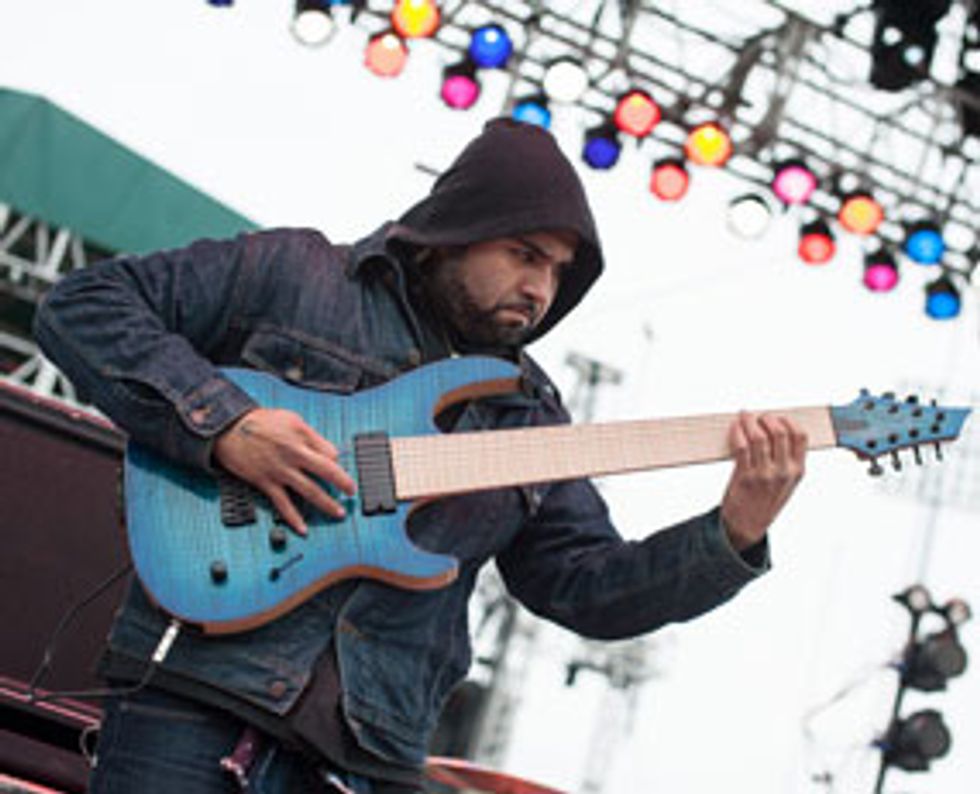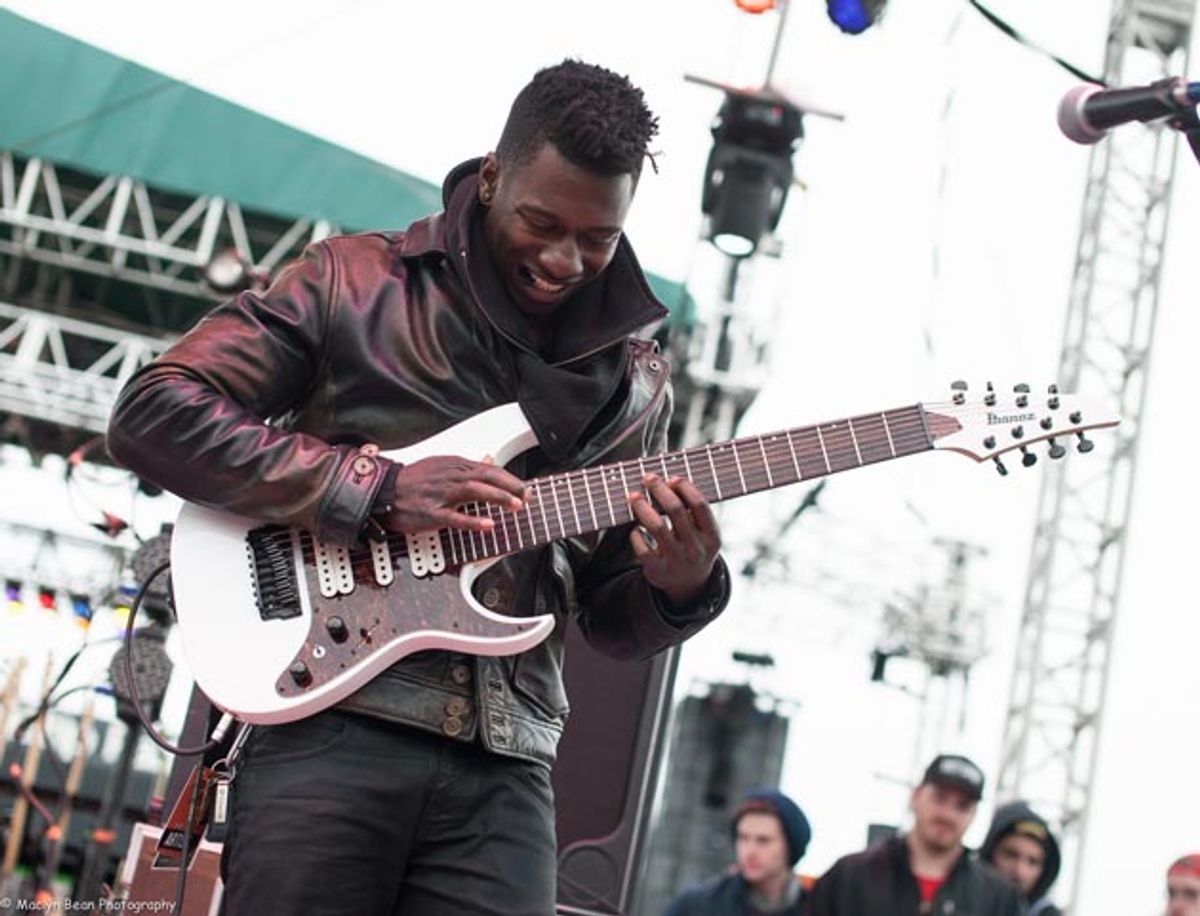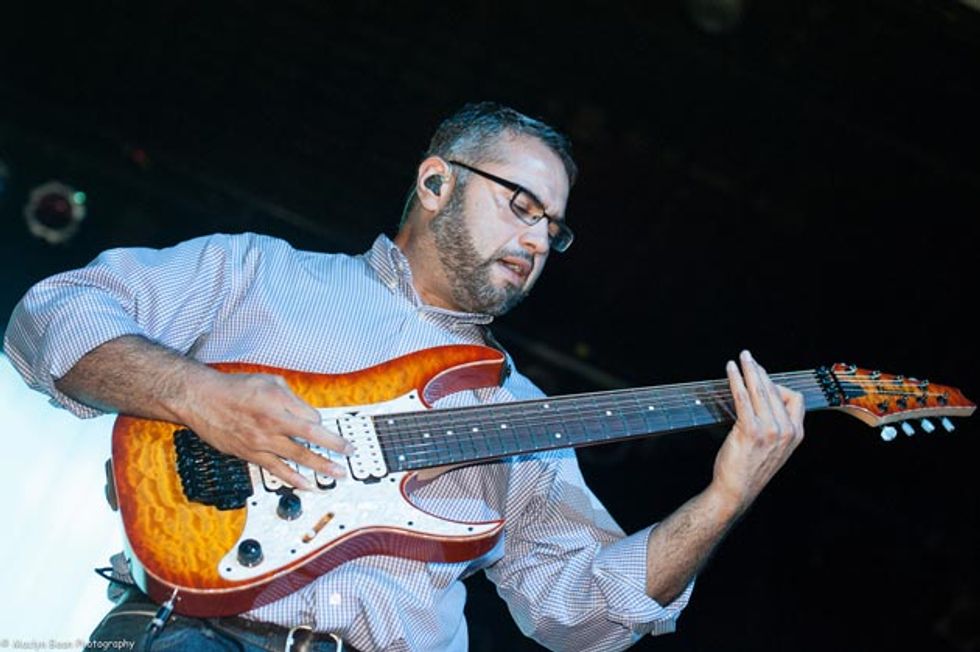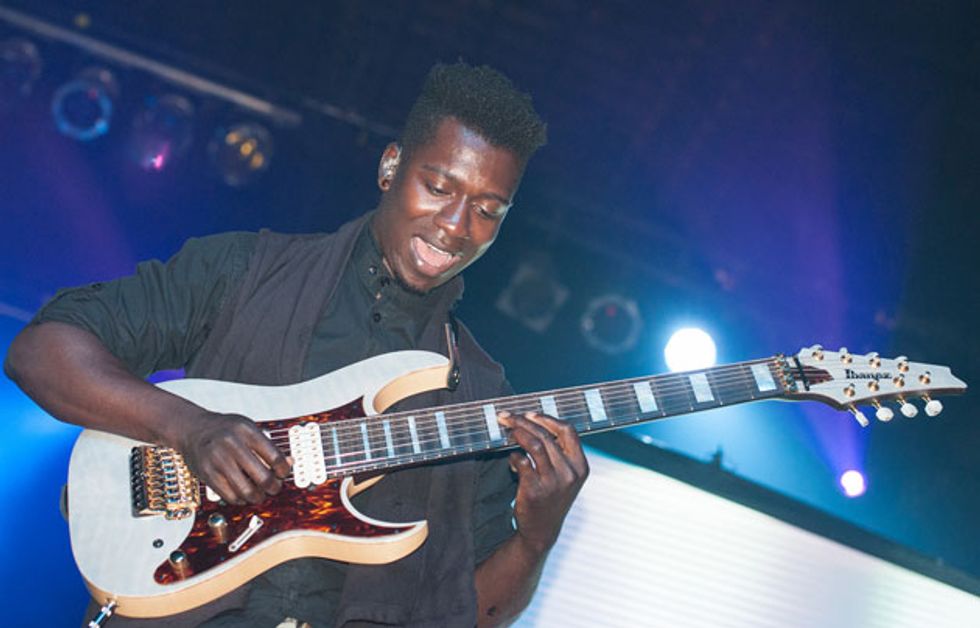Prog-metal titans Tosin Abasi and Javier Reyes dissect their most boundary-breaking release to date.
For a band that’s generally placed under the prog umbrella, Animals as Leaders has extraordinary popular appeal. On the trio’s recent tour, the audience was far more diverse than the ubiquitous living-in-mom’s-basement, Dungeons & Dragons set. It can seem like there are more females at one Animals concert than Rush, the godfathers of prog, have managed to draw over their four-decade career.
“We’re not necessarily just a progressive metal band,” explains bandleader Tosin Abasi. “If you try to put Animals as Leaders into a certain box, there are some songs that don’t fit into that box.”
Elements of electronica, dance, and ambient music have always imbued Animals as Leaders’ sound, crossbreeding with metal and djent. The band’s new release, The Joy of Motion, pushes stylistic boundaries to the breaking point with distinct jazz and Latin flavors. But even in this schizophrenic sonic landscape, the group’s sound always returns to Abasi’s advanced harmonic language and superhuman guitar virtuosity, which can test anyone’s physical limits. As proof, a classical cellist who performed a YouTube rendition of AAL’s “CAFO” admits to having sped up the fast parts digitally. If a classical virtuoso can’t keep up, well, good luck, fellow pickers!
Animals began as Abasi’s solo project. He enlisted Periphery’s Misha Mansoor to produce some guitar demos and the result, Animals as Leaders (2009), made Abasi an overnight guitar hero. Co-guitarist Javier Reyes and drummer Navene Koperweis fleshed out the lineup for the next release, Weightless. On The Joy of Motion,Matt Garstka takes over drum duties from Koperweis. Garstka, a Berklee student and longtime Animals’ fan, got the call from Abasi out of the blue after a recommendation from Berklee alum Ivan Chopick. Yes, kiddos, prog-rock dreams do come true.
The Joy of Motion features a large cast of characters.
Tosin Abasi: It’s probably the most inclusive of outside band members. We worked with Misha, Adam “Nolly” Getgood, and Diego Farias, so it was sort of a triple-produced, collaborative thing. Navene did all of the electronic production. It’s also the first album to have fully acoustic drums with a fully human drum performance. We’ve always programmed drums before.
Javier Reyes: On the first album, Tosin and Misha were just putting these songs together, and there wasn’t necessarily an overall goal or an overall sound they were going for. Since then the band has evolved. The Joy of Motion is more representative of who we are as players.
Javier, you contributed a few songs to The Joy of Motion.Reyes: Correct. Some of the stuff I write can fit in the realm of what Animals as Leaders is, and sometimes it’s outside of that. I’m okay with coming into the picture saying, “This is useful, this is not useful,” as well as just going along with what’s already present.
Your composition “Para Mexer” has a strong Latin influence. Is there a stylistic line that you guys have to beware of crossing before alienating your core audience?
Reyes: The more we do Animals as Leaders, the more we blur that line. The way I write is sometimes Latin-based, and for some reason, the style of this album allowed it to fit in more so than it would have fit into previous albums. Overall, I think what people appreciate about us is that we’re using all of these influences from outside genres in the context of metal. We’re trying to just write for ourselves, in a way.

Javier Reyes rocking out with his signature Carvin prototype during the South By So What? festival on March 16, 2014. The in-progress model shown here has an ash body and flame-maple top, and he also has another prototype with walnut in the body and neck. Photo by Maclyn Bean.
Abasi: It’s funny that you mentioned that, because this album was the first where we disregarded a lot of those rules. There’s some Latin-y stuff and some jazzy stuff, and our fans really seem to respond to it, so it’s cool that they’re open to our musical identity being flexible. We just try to make music that represents our interests and our aestethics. We try not to worry about that other stuff too much.
In the interlude on “Ka$cade,” at around 1:41, the first chord sounds like the opening chord to Allan Holdsworth’s “Three Sheets to the Wind.”
Abasi: Yeah, it’s a Holdsworth voicing for sure. He’s an example of someone who has such a distinct voice that you can’t come anywhere close to what he’s doing without being really obvious about who you’re taking it from. Sometimes I like to channel people directly. He kind of arpeggiates that chord, though I play it all at once.
The interlude in “Nephele” also has a lot of colorful dissonance, but it sounds like it’s coming from a different place than the Holdsworth school.
Abasi: That’s Javier’s composition. He’s not as much of a Holdsworth guy. He’s coming more from a Spanish classical thing, guys like Yamandu Costa and [Agustín] Barrios. He has this teacher, Julio “Koko” Sosa, who has a lyrical, folkloric approach to guitar. He’s like a mix between Joe Pass and Paco de Lucía. Javier kind of internalized this guy’s style because he was basically apprenticing with him for many years. When Javier writes, you really hear that coming out.
Reyes: When I was writing it, it had a 6/8-type of vibe. I was originally writing it on my own then Tosin walks into the house, hears it, and says, “There’s another song.” [Laughs.] It was literally like, “That’s sick. Cool—we’re using it.”
It sounds like you’re using the augmented scale on “Lippincott.”
Abasi: Yeah, it’s totally the augmented scale. There’s some harmonic major stuff as well. There’s this dude, Tom Lippincott, who is one of the instructors for Mike’s Master Classes [mikesmasterclasses.com]. I bought a few of his classes, and on one of them he was breaking down the diatonic structure of the harmonic major scale. Man, that’s an amazing scale. I kind of got obsessed. So “Lippincott” employs all the melodic concepts I learned from watching Tom’s videos.
“What people appreciate about us is that we’re using all of these influences from outside genres in the context of metal.”
—Javier Reyes Photo by Maclyn Bean.
Tosin, even though you’re an acclaimed guitar virtuoso, you’re always trying to learn more.
Abasi: That stuff is like creative fuel for me. Whenever I’m in a rut, I just go find some classes, and usually I’m able to write music from what I learned. I also ended up subscribing to Tim Miller’s online lesson site [members.internetguitarlessons.tv]. He’s awesome. When I start to do stuff like that, then I want to sound like Tim Miller. I think my playing is pretty heady. I’m no Tim Miller or Holdsworth, but the tonalities I gravitate to are a bit towards the adventurous side.
Curiously, “Tooth and Claw” has an Yngwie-like, harmonized diminished run. I was surprised to hear that because your harmonic vocabulary seems to move away from the moves popularized by the Shrapnel shredders.
Abasi: We were referencing Bill and Ted’s Excellent Adventure, like Wyld Stallyns. [Laughs.] Nolly, who is an amazing guitar player, was like, “Let’s try to bring out different elements of your playing.” He started playing a lot of Andy Timmons, Stevie Ray Vaughan, and even some John Mayer and Dimebag Darrell. It was like, “Fuck it man, let’s just wail a little bit”—just unapologetic electric guitar. The first bends are harmonized and have really wide vibrato. That’s something I don’t normally do. I rarely bend, just because 7-and 8-string guitars have extended ranges and don’t really allow for the same level of control because the tension’s greater. There are more strings, the necks are bigger, and you can’t really achieve the same finger positions as on a Strat or a Les Paul. Anyway, that diminished run wasn’t exactly tongue-in-cheek, but it was like, “This is an electric guitar solo. We’re going to harmonize it and pull out some Jason Becker stuff.”
Tosin Abasi's Gear
Guitars
Ibanez TAM100
Ibanez TAM10
Strandberg
Rick Toone “Blur”
Amps
Fractal Audio Axe-Fx II
Port City Pearl 100W head
Port City OS Wave 2x12 cab
Effects
Fractal Audio Axe-Fx II
Strings and Picks
D’Addario strings (.009-.074)
Planet Waves Black Ice .55 mm picks
Planet Waves cables
Javier Reyes' Gear
Guitars
Carvin signature model
Amps
Fractal Audio Axe-Fx II
Port City Pearl 100W head
Port City OS Wave 2x12 cab
Effects
Fractal Audio Axe-Fx II
Strings and Picks
D’Addario strings (.010-.074)
Planet Waves Black Ice .80 mm picks
Monster cables
Tour Supply straps
Planet Waves clip-on straps
Your playing is more blues-based on this album than on previous releases.
Abasi: This was parallel with me discovering certain guitar players who are more blues-based, like Jimmy Herring, or Jairus Mozee, who plays with Prince. I really got into this kid, Isaiah Sharkey, who plays for D’Angelo and Chris Dave. He grew up playing in church, so it’s like this gospel, neo-soul thing. If it’s not some of the best guitar playing I’ve ever heard! It knocked me on my ass. He’s like 24. He’s gonna hurt your feelings really bad. Like, it’s not okay. [Laughs.]
That’s a whole different bag from what people associate with you.
Abasi: These guys are coming from a whole different angle with the double stops and the major triads. I spent the last year obsessing over these guys, and when it came time to record the solos for this album, my approach to phrasing kind of mutated. I didn’t feel like I needed to play a million notes. I was more concerned with the right notes. Not that I wasn’t before, but my aesthetic is definitely different, so I think that’s one big difference on this album.
Is this just a phase, or will future albums feature more bends and less flash?
Abasi: Probably, because the endgame is just lyrical playing. I want people to hear the solo and not tune out. I want them to tune in. I don't want just guitar players to tune in. Melody is melody. I want to impact people. There are non-guitarists who love Slash’s solos. I’ve seen footage of people singing the guitar solos.
How do you manage to memorize everything flawlessly for the live shows? It seems like there’s no room for error at all.
Reyes: You’re absolutely right.
Abasi: No margin for error. Not even an eighth-note. Our songs are actually not very complex. There’s a good deal of repetition. A lot of instrumental bands have very sweeping compositions with lots of dense parts. We’ve done maybe 50 to 75 shows with Between the Buried and Me, and there are still parts of their material where I don’t even know how they remember it. Everyone’s mind works differently. I never strived to make something super-dense as far as composition was concerned. There are a lot of layers, but our songs on The Joy of Motion are all under six minutes.
What happens if you screw up a run live?
Abasi: We don't mess up! [Laughs.] I’m not perfect, and for a lot of the material there’s a degree of muscle memory. It’s not like you’re streaming the improvisational mind. You need to reproduce something that’s been recorded—perfectly. You need to be consistent. For the most part, shit works out.
Reyes: It happens all the time. There’s little brain fart where for some reason, I’m thinking about something like where I left my car keys. If it’s one of us, we can all look at each other and say like, “You’re a little ahead or behind.” When you open your eyes wider, that means you fu*ked up. [Laughs.]
Do you play to a click track live?Reyes: It’s funny—when Navene was in the band, I never played to a click. When Matt joined the band, he was way more into the deep displacement. I was like, “I can’t keep up with this guy!” And the first tour we did with him was with Meshuggah, so it was like, “I need to have this click in my ear!” We did one show in Europe without the click, and it was horrendous. We got through it, but there were definitely some sections where we were like, “Oh, god.” All of us. The way Matt ends “CAFO” now is intense. He’s moving the beat and doing all sorts of crazy stuff, so we need that click in there.
Abasi’s main axe is his TAM100 with DiMarzio Ionizer 8 pickups, a quilted-maple top, basswood body,
and a wenge/bubinga neck. Photo by Maclyn Bean
Is the click track programmed with different meter changes, or is it just a pulse?
Reyes: The click track is usually an eighth-note pulse. We do riffs with odd meters, but if you have that eighth-note click track, you’re always on, whether it’s an upbeat or a downbeat. Sometimes there are little accent marks. On this last tour we even had cues where we put a clap along with the click. Matt is doing some of the craziest drumming ever, so we have claps to cue us in for the upcoming parts. It’s just anything to help make the show tighter for us.
Let’s talk gear. Are you guys still using the Axe-Fx II?
Abasi: Yeah, Axe-Fx II for everything. We have these Port City Pearls. They’re single-channel, point-to-point handwired, super-clean boutique tube heads. Daniel Klein, the company’s owner and main builder, also has an Axe-Fx, and he was unhappy with a lot of the amplification options, so he made this head, he says, “to inhale pedals.” It’s basically like a blank slate for guys who are running $350 Tube Screamers and stuff like that, but it’s not sterile—it imparts a lot of cool dynamics and character. So we tone-matched the Port City amp through the 2x12 OS Wave cab that he makes as well, and that tone match is a part of every tone you hear on the album—it’s all coming from the same virtual amp and cab. We do the same thing live, but onstage we actually have the physical amps for monitoring. We send the direct signal through the front of the house.
What about guitars?
Abasi: My main axe is my signature Ibanez TAM100. Man, that thing just sounds great. The DiMarzio Ionizer 8 pickups mixed with the wenge and basswood combination is super-pleasing but versatile. I’m really happy with it. That’s what I use for virtually everything. I was also playing the TAM10, a lower-tier model, on this tour, partially to promote it, but also because it’s a great guitar. It has a maple neck, so it’s a bit brighter. There’s also a Vigier Excalibur 7-string that I use for some solos, and a nylon 7-string that Godin was kind enough to give me. That’s featured on “Para Mexer.” It’s Javier playing primarily.
YouTube It
Animals as Leaders tears it up on “Ka$cade” at La Tulipe in Montreal. Check out the Holdsworth-ian interlude starting at 1:49, accompanied by audience applause and raised devil horns.
Javier, what can you tell us about your upcoming Carvin signature model?
Reyes: We’re starting the prototypes right now. I’m experimenting with a lot of things, from chambered vs. non-chambered to different types of woods.
In the meantime, which guitar are you going to bring on tour?
Reyes: More than likely one of the two Carvins I have. The blue one in the pictures has an ash body and flame-maple top, and I recently got another one with a walnut body, flame-maple top, and a walnut/maple neck. I used it at the last show at the Roxy. The walnut sounds amazing. It’s pretty round—a little more round than I was expecting.
What about those unconventional fanned-fret, compound-scale guitars you guys have?
Abasi: I have a Strandberg guitar, and a Rick Toone guitar called “Blur.” It’s this weird baritone 8-string thing. For the 7th and 8th string, the fretboard extends a minor 3rd lower than the rest of the neck. We took these two guitars on tour to perform the song “Physical Education” because it features a C# tuning.
Reyes: On the tour I have to use Tosin’s guitars for those songs—unless I can get Carvin to make me something like that.
Abasi: I’m really into ergonomic guitars. I’m thinking of concepts for my next signature guitar, and ergonomics is something I really want to bring to Ibanez.
You’re probably the only guy who can make these quirky guitars cool and marketable to the masses.
Abasi: Totally. We’ll see how it goes.




